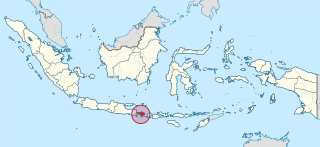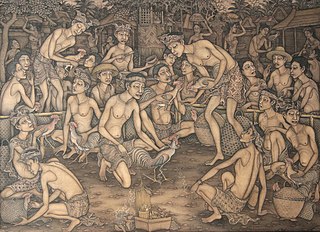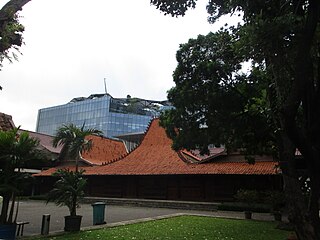
Bali is a province of Indonesia and the westernmost of the Lesser Sunda Islands. East of Java and west of Lombok, the province includes the island of Bali and a few smaller offshore islands, notably Nusa Penida, Nusa Lembongan, and Nusa Ceningan to the southeast. The provincial capital, Denpasar, is the most populous city in the Lesser Sunda Islands and the second-largest, after Makassar, in Eastern Indonesia. The upland town of Ubud in Greater Denpasar is considered Bali's cultural centre. The province is Indonesia's main tourist destination, with a significant rise in tourism since the 1980s, and becoming an Indonesian area of overtourism. Tourism-related business makes up 80% of the Bali economy.

Balinese Hinduism is the form of Hinduism practised by the majority of the population of Bali. This is particularly associated with the Balinese people residing on the island, and represents a distinct form of Hindu worship incorporating local animism, ancestor worship or Pitru Paksha, and reverence for Buddhist saints or Bodhisattava.
I Made Bandem is a Balinese dancer, artist, author, and educator.

The 2008 Asian Beach Games or ABG 2008, officially the 1st Asian Beach Games and commonly as Bali 2008, the inaugural Asian Beach Games, was held in Bali, Indonesia, from 18 to 26 October 2008. The opening ceremony was held in the Garuda Wisnu Kencana Cultural Park in Nusa Dua.

Nyepi is a Balinese "Day of Silence" that is commemorated every Isakawarsa according to the Balinese calendar. It is a Balinese celebration mainly celebrated in Bali, Indonesia.

Dance in Indonesia reflects the country's diversity of ethnicities and cultures. There are more than 1,300 ethnic groups in Indonesia. Austronesian roots and Melanesian tribal forms are visible, and influences ranging from neighboring Asian and even western styles through colonization. Each ethnic group has its own dances: there are more than 3,000 original dance forms in Indonesia. The old traditions of dance and drama are being preserved in the numerous dance schools which flourish not only in the courts but also in the modern, government-run or supervised art academies.

Balinese art is an art of Hindu-Javanese origin that grew from the work of artisans of the Majapahit Kingdom, with their expansion to Bali in the late 14th century. From the sixteenth until the twentieth centuries, the village of Kamasan, Klungkung, was the centre of classical Balinese art. During the first part of the twentieth century, new varieties of Balinese art developed. Since the late twentieth century, Ubud and its neighboring villages established a reputation as the center of Balinese art.
I Nyoman Renbang (1937–2001) was an Indonesian musician, composer, teacher and instrument maker. He is considered by many ethnomusicologists as one of the most influential Balinese musicians and composers of the twentieth century.

Ida Bagus Made Poleng (1915–1999) was a traditional Balinese painter. Known also as Ida Bagus Made Poleng or Ida Bagus Made Tebesaya or simply Gus Made.

The Puri Lukisan Ratna Wartha Museum is the oldest art museum in Bali which specialize in modern traditional Balinese paintings and wood carvings. The museum is located in Ubud, Bali, Indonesia. It is home to the finest collection of modern traditional Balinese painting and wood carving on the island, spanning from the pre-Independence war (1930–1945) to the post-Independence war era. The collection includes important examples of all of the artistic styles in Bali including the Sanur, Batuan, Ubud, Young Artist and Keliki schools.

The Indonesia Museum, is an anthropology and ethnological museum located in Taman Mini Indonesia Indah (TMII), Jakarta, Indonesia. The museum is concentrated on arts and cultures of various ethnic groups that inhabit Indonesian archipelago and formed the modern nation of Indonesia. The museum is a richly decorated building in Balinese architecture. The museum boasts a comprehensive collection consisting of over 1,000 pieces of traditional and contemporary Indonesian arts, crafts and traditional costumes from the different regions of the nation.
Balinese literature refers to the oral and written Balinese language literature of the people of Bali, an island in Indonesia. It is generally divided into two periods: purwa, or traditional; and anyar, or modern.

The cendrawasih dance is a Balinese dance which is performed by two female dancers and illustrates the mating rituals of the bird of paradise.

Bentara Budaya Jakarta is a cultural center located on Jalan Palmerah Selatan 17, Central Jakarta, Indonesia. The institution consists of a museum and an art gallery. Open from Monday to Friday at 8 AM to 5 PM, the gallery is closed on weekends and holidays, with an exception being made when special exhibitions are present. Entry to the gallery is free of charge and open to visitors.

A wantilan is a Balinese pavilion (bale) used for activities involving large crowds. A wantilan is the largest type of bale in Balinese architecture. A wantilan is basically a large wall-less hall placed under a large multi-tiered roof. A wantilan as a public building is usually located at a village's main square or main junction and functions as an open hall to hold large community activities such as meeting halls or a public musical gamelan performance. A wantilan is also a religious building, an integral part of Balinese temples used to hold the Balinese cockfighting ceremony.

The 2018 Bali gubernatorial election took place on 27 June 2018 as part of the simultaneous local elections. It was held to elect the governor of Bali along with their deputy, whilst members of the provincial council will be re-elected in 2019.

Laksmi Shari De-Neefe Suardana, simply known as Laksmi De-Neefe Suardana, is an Indonesian fashion designer, author, UNICEF activist, 2022 G20 Ambassador, co-founder of Ubud Writers and Readers Festival, model and beauty pageant titleholder who was crowned Puteri Indonesia 2022. Suardana is the first representative from Bali to be crowned Puteri Indonesia. She represented Indonesia at Miss Universe 2022.

The Taman Werdhi Budaya Art Centre is an art and cultural centre in Denpasar, Bali, Indonesia. It serves as a place for art performances, especially traditional Balinese arts, dances, musics and theatres. It was inaugurated by the Governor of Bali, Ida Bagus Mantra. The five-hectare site consists of art exhibition buildings, an open theater, an indoor theater, a Balinese history library, and a Hindu temple. It is the venue for the annual Bali Arts Festival, a month-long Balinese traditional arts festival since 1979.















